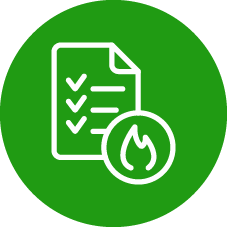Risk Assessments and
Method Statements (RAMS)
Risk Assessments and Method Statements (RAMS) FAQ
How often should RAMS be reviewed?
Reviewing your risk assessment and risk management practices is advised annually or whenever there is a substantial change to your workplace, such as how it operates or its design. New machinery, substances and procedures should also influence a review of your risk assessment and management practices. Likewise, if there is an injury or accident as a result of hazard exposure.
What is the purpose of a risk assessment and method statement?
Because they’re both common health and safety documents, people get them mixed up. While the differences are subtle, it’s important that you know the difference between risk assessment and method statements.
Risk assessments identify and assess the hazards and risks at work and from here, suggest control measures to mitigate the risk. Method statements detail step by step how a task should be completed safely.
What comes first, risk assessment or method statement?
Risk assessments make up the basis of a method statement, and therefore, should always be done first. The risk assessment will identify if an activity is high risk or complex, while the method statement will detail how the job or task is to be carried out safely.
How many parts are there to a risk assessment?
A risk assessment will protect workers and the public from hazards. As well as identifying the hazards, it should put precautions in place to prevent accidents and ill-health in the workplace.
There is no right or wrong way to do a risk assessment. Though there are five steps to follow that ensure it has been carried out correctly. The five steps are:
- Identify the hazards
- Decide who might be harmed and how
- Evaluate the risks and decide on control measures
- Record your findings and implement them
- Review your assessment and update if required
Who is responsible for writing RAMS?
It is the employer’s responsibility to ensure the health and safety of employees and contractors and therefore, it is the employer’s job to make sure RAMS are carried out and the right precautions are put in place to prevent anyone from getting hurt.
What are the legal requirements of a risk assessment?
Whether you’re an employer or self-employed, UK law states that you must carry out and conduct risk assessment practices. The 1999 Management of Health and Safety at Work Regulations (MHSWR) states that employers must:
- Assess risks to self, employees and any other people who have contact with the workplace or work processes.
- Review and assess over time and address any changes.
- In the case of organisations with five or more employees, keep a record of risk assessment findings, and identify people who are considered at risk.
What is ISO31000?
Published in 2009, ISO31000 is an international standard for Risk Management and can be used by any type of organisation. Outlining a generic approach, it provides guidelines and principles for effective risk management, which can be used for a variety of risks, including financial, safety and project risks.
ISO31000 provides a uniform vocabulary and concepts for discussing risk management, as well as guidelines and principles that help to undertake a review of your business’s risk management process.
Need a risk assessment for your business?

Related Services

Safe Systems of Work

Fire Risk Assessments

Accident Investigations

Looking for expert health & Safety support?
We can help you focus on your business by taking care of all your health & safety needs.
Let us know how we can help or ask about our free initial H&S review.
Sensible Safety Solutions
Subscribe to our newsletter
| VAT Number: 900674738 | Registration Number: 06316590
Copyright © 2007 – 2019 The H&S Dept Ltd. H&S DEPT is a registered trademark belonging to The H&S Dept Limited.

